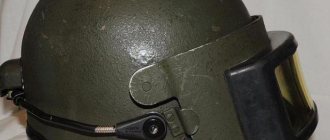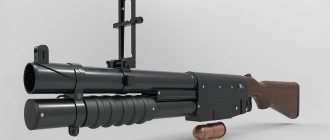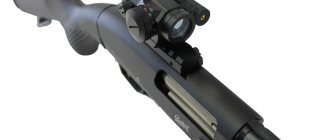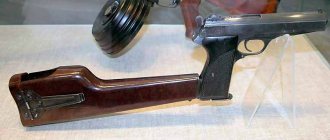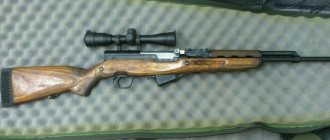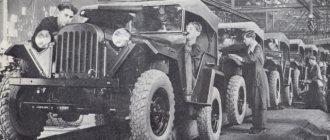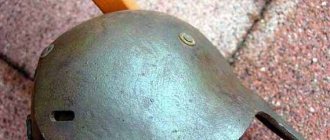SSH-68 (steel helmet model 1968)
— further development of the combined arms helmet SSH-60.
It differs from the earlier sample in greater strength, a greater slope of the front (frontal) wall of the dome and shortened sides bent outward. The underbody device remains the same, as well as the location of the fastening rivets. The helmet was painted dark green[1].
The weight of the helmet is 1300 grams (with a leatherette under-the-face device - 1500 grams). SSh-68 provides protection against non-ballistic impacts (melee weapons, etc.), as well as steel fragments weighing 1.0 grams at speeds up to 250 m/s[2]. Doesn't protect against bullets.
Helmet SSH-68/SSh-68M/SSh-68N. Review, photos, characteristics.
SSh-68 (steel helmet model 1968)
- a further development of the combined arms helmet SSh-60.
It differs from the earlier sample in greater strength, a greater slope of the front (frontal) wall of the dome and shortened sides bent outward. The underbody device remains the same, as well as the location of the fastening rivets. The helmet was painted dark green [1].
The weight of the helmet is 1300 grams (with a leatherette under-the-face device - 1500 grams). SSh-68 provides protection against non-ballistic impacts (melee weapons, etc.), as well as steel fragments weighing 1.0 grams at speeds up to 250 m/s [2]. Protects against bullets according to the 1st protection class (according to the old classification).
Notes[edit]
- https://ultimatehistoryproject.com/headstrong.html
- Sergey Monetchikov. Uniform: From helmet to steel helmet “Big Brother” Magazine, No. 6, June 2009 www.bratishka.ru/archiv/2009/6/2009_6_14.php
- Dmitry Mamontov. Cast Iron Lob: Keep Your Head "Popular Mechanics", February 2007. https://www.popmech.ru/article/1197-chugunnyiy-lob/page/1/ Archived October 10, 2013 at the Wayback Machine.
- ^ a b c d e https: //www.m militarytrader.com/militaria-collectibles/from-behind-the-iron-curtain-communist-bloc-helmets
- NL-68M, steel protective helmet, modernized “Archival copy”. Archived from the original on 2012-12-08. Retrieved 14 July 2012.CS1 maint: archived copy as title (link)
- https://www.gostak.co.uk/composites/russia/
- modernized bulletproof helmet NL-68N “Blank” https://shooter.com.ua/zashhita/966-modernezirovannyj-pulestojkij-shlem-ssh-68n-zagotovka.html Archived 11/01/2012 on the Wayback Machine
- "Archival copy". Archived from the original on April 26, 2022. Retrieved 24 May 2022.CS1 maint: archived copy as title (link)
- https://brendonshelmets.weebly-.com/syria-ssh68.html
- "Archival copy". Archived from the original on April 26, 2022. Retrieved 24 May 2022.CS1 maint: archived copy as title (link)
- "Mũ chống đạn của Quân đội Việt Nam chịu được n 9mm". netnews.vn
. Archived from the original on April 16, 2022. Retrieved April 16, 2019. - https://brendonshelmets.weebly.com/vietnam-ssh60.html
- https://brendonshelmets.weebly.com/lithuania-ssh68.html
- https://brendonshelmets.weebly.com/mongolia-ssh68.html
- https://mahargpress.com/m military-
helmets
/
chapters-summaries
/
central-america
/
nicaragua/ - "Archival copy". Archived from the original on April 26, 2022. Retrieved 24 May 2022.CS1 maint: archived copy as title (link)
Options and modifications
- SSh-68M
(GRAU index - 6B14) - modernization of SSh-68 by strengthening the helmet shell from the inside with ballistic fabric (aramid), as well as installing modern belt suspension and retention systems. As a result, the weight of the helmet is increased to 1.9 kg. The helmet was developed by the State Research and Production Association “Special Equipment and Communications” of the Ministry of Internal Affairs of Russia for the personnel of the internal troops. SSh-68M provides head protection according to the 1st protection class (from PM pistol bullets and revolver bullets) [3]. - SSh-68N “Blank”
(GRAU index - 6B14) - modernization of SSh-68 by strengthening the helmet shell from the inside with ballistic fabric (aramid), as well as installing modern belt suspension and retention systems. As a result, the weight of the helmet is increased to 2 kg. The helmet was developed by the Steel Research Institute for military personnel. The helmet provides head protection according to the 1st protection class (from PM pistol bullets and revolver bullets), as well as from spherical steel fragments weighing 1.1 g (fragment diameter 6.3 mm) at speeds up to 400 m/ from [4].
Users[edit]
Current[edit]
Syrian army special forces in SSh-68 firing from an ATGM MILAN
- Angola [4]
- Armenia
- Azerbaijan [8]
- Belarus
- Cuba [4]
- Egypt [4]
- Moldova
- North Korea
- Philippines - Donated by Russia and used by Army reservists.
- Syria [4] [9]
- Ukraine [10]
- Uzbekistan
- Vietnam [11] [12]
Former[edit]
- Afghanistan [4]
- Lithuania [13]
- Mongolia [14]
- Nicaragua [15]
- Russia [16]
- Soviet Union
Operating countries
The SSH-68 helmet was in service with the USSR Armed Forces and the Warsaw Pact countries, as well as Vietnam, China, North Korea, India and other countries.
After the collapse of the USSR in 1991, SSh-68 helmets remained in service with the armies of the post-Soviet countries.
Due to the advent of more advanced helmets, the SSh-68 is gradually being removed from equipment (in the Russian armed forces it is gradually being replaced by 6B27 and 6B47 helmets; the Estonian army has received five types of imported helmets since the early 1990s [5], the Georgian armed forces in In the mid-2000s, imported PASGT helmets began to arrive [6], the Armed Forces of Ukraine began to receive the Kaska-1M helmet in the first half of 2014, and the Armed Forces of Belarus received ZSh-1 and ZSh-1-2 helmets at the end of November 2014 [ 7] ).
Notes
Russia Visor series (6B11 6B12 6B13) 6B15-1 6B17 6B18 6B19 6B20 6B24 “Strawberry-O” 6B21 (6B21 6B21-1 6B21-2) 6B23 6B22 (6B22 6B22- 1 · 6B22-2) · 6B23-1 · 6B33 · 6B43 · 6B45 · 6B46 · 6B49 · Grenadier · Defender · Knight · Warrior · Challenge · KORA-1MK · · Cuirass (Breastplate-Universal · Cuirass-Universal CH · Cuirass L · Cuirass N · Cuirass R · Cuirass D · Cuirass F · Cuirass F) Helmets Russia SSSH-94 (SPHERE-S) Alpha Alpha-P Alpha-2 ZSh-1 ZSh-1-2 ZSh-1-2M ZSh-09 6B6 6B7 (Borit-M) (6B7- 1MM) · 6B27 (6B27M) · 6B43 · 6B47 · Lynx-T · K6-3 · LShZ-2DT · LShZ-PU · Jeta-SO · Tor · Cuirass-BSh670 · Kiver-RSP · ShBM (ShBM-P · ShBM- L · ShBM-A) · Silo type "N" · Silo type "V" · AZSh-2 · K-1SB Kolpak-1 · Kolpak-2 (Kolpak-2M) · Kolpak-3 (Kolpak-3M) · Ural · Skat (Skat M1 · Skat-S · Skat-2DT) Other L-1 · OZK (OZK-F) · 6B15 "Cowboy" · 6B25
The last steel
Domestic steel helmet SSH-68
The history of the creation of army steel helmets of the Soviet period (in common parlance, helmets), despite the small number of models (the fingers of one hand are enough to count) and the not so great distance of these events in time, is completely replete with blank spots, raising a lot of questions, the answers to which may are already irretrievably lost. With this article we are trying to somewhat improve this situation.
The history of the creation of a steel helmet mod. 1968 (SS-68), although distant from modern times by only a few decades, is also far from completely described. The origins of the very idea of creating a new helmet lie in the early 60s of the last century. During the Soviet period, the issue of unification of weapons and ammunition within the framework of the Warsaw Pact received unremitting attention. For this purpose, comparative tests of small arms and cartridges manufactured in the countries in which they were produced were organized at intervals of ten years. The purpose of these tests was to comparatively test the reliability, service life and interchangeability of parts, the unity of ballistic characteristics and the special action of bullets.
During such tests in 1962-63. when determining the penetrating effect of bullets by shooting at steel helmets, the best bullet resistance of the M-56 helmet made in the GDR was revealed (compared to the steel helmet model 1960 SSh-60, recently adopted and supplied to the USSR Armed Forces, by an average of 3-6%). Concerned with this circumstance, the General Staff of the USSR Ministry of Defense in 1964 issued instructions to the Technical Committee of the Department of Clothing Supply of the Ministry of Defense to open research work to study the possibility of creating a new steel helmet with protective properties increased by 10% compared to those of the SSh-60. In 1965, the technical committee of the clothing supply department of the Moscow Region formulated the requirements for a new helmet and issued the task for its development to the Volgograd State Order of Lenin and the Order of the Red Banner of Labor Metallurgical Ministry of Ferrous Metallurgy (“ZKO”, enterprise PO Box A-7653). From the very beginning of the work, it was clear that it would not be possible to achieve the required protective characteristics of the new helmet only through the development of a new dome shape. For this reason, the Leningrad Research Institute-13 (enterprise PO Box R-6762, after 1965 Central Research Institute of Materials - TsNIIM) was involved in the work in order to study the possibility of developing a new armor steel with improved characteristics.
Helmet SSH-68/SSh-68M/SSh-68N. Review, photos, characteristics.
Designed to protect the human head in class 1 in accordance with the requirements of GOST R 50744-95 and is a modernized standard army helmet (SSh-68).
The SSH-68M helmet was developed by the State Research and Production Association “Special Equipment and Communications” of the Ministry of Internal Affairs of the Russian Federation, has been tested, certified and is used in the special forces of the Internal Troops of the Ministry of Internal Affairs of the Russian Federation.
It differs from its analogue (SSh-68) in increased armor protection and reduced impact of bullets and shrapnel on the human head due to special metal processing and reinforcement from the inside with aramid fabric armor. Withstands PM pistol bullets from a distance of 5 meters.
protective helmets of the Russian Federation, special and army. BASE
#26 Raccoon
- Users
- 1988 messages
- Moscow city
Photo from the official website of the manufacturer.
Both versions of the helmet are presented. With and without a visor. All Vityaz-S helmets that have ever passed through our fellow collectors were of “unit” origin. However, there are indecently few examples of practical use of the Vityaz-S helmet. Below is a photograph (as you can understand - “staged”) of an example of the equipment of a tax police stormtrooper from the “physical protection department”. Photo from the publication “Taxes Yesterday, Today, Tomorrow”, 1997, for the provision of which special thanks go to the participant Kapitan1969 (Dmitry, thank you!). There is also another photo from the depths of the Internet. What kind of unit it is is unclear, the explanation for the photo was simple - “Chechnya”. Judging by the night light, Vintorez, these are not simple explosives. There has been (and still is) quite a lot of talk, based mainly on photographs from the old website of the manufacturer, the Scientific Research Institute of Steel, about the existence of a visorless version of the Vityaz-S helmet. That same photograph (above) actually shows a helmet that is visually different from its brother with a visor in that it does not have brackets for the visor, there are no stoppers or a latch. It is also noticeable that the side walls of the helmet are much higher. That is, they are actually circumcised. As for the subtural device, it is clear that it is similar. The photo shows a rather interesting specimen, which initially did not have a visor. The photo clearly shows that the helmet was not originally equipped with a visor kit. But this helmet still has such an “anachronism” as a small visor. My guess is that this visor performed some kind of anti-ricochet function, so that the bullet would not accidentally go into the gap between the helmet and the top of the visor. At the same time, it is clearly visible that the side walls of this helmet are identical in size to a standard helmet with a visor. A huge advantage of this helmet is that the helmet in the photo is an element of real combat equipment of a special unit of the Internal Troops of the Ministry of Internal Affairs, that is, the helmet is not some completely non-serial item. This helmet, by the way, served its owner, a respected serviceman of the Air Force of the Ministry of Internal Affairs, with real service: in the area of the frontal projection you can see the trace of a hit from a 9 mm 9x18 (PM) bullet. As you can see, it’s not like it’s broken, it’s just an indistinct dent. By the way, this example well illustrates the reason why many fighters still use the Vityaz-S helmet, despite its weight and questionable ergonomics. By the way, the fighter is alive and well, which once again indicates the fragility of the myth about the fracture of the cervical vertebrae when a bullet hits a heavy helmet. The helmet, as you can see, has the same configuration (and therefore weight) as its visor counterpart. It is quite possible that during the further production of helmets the manufacturer decided not to trim the side walls. And the protection area is reduced, and the extra technological operation is not particularly useful for production. The sub-unit device is absolutely identical. There is even the famous glamorous pink cord on the face that tightens the slings of the under-tool device.
